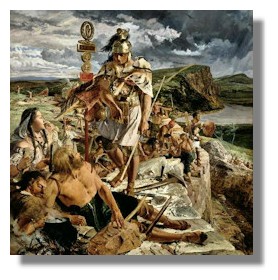From Higgins's book concerned with an historical hoax, which might be titled "Turning Bad English into Worse Latin":

While surveying, Roy also indulged a passion: his deep interest in Scotland's Roman past. He took detailed plans of numerous forts, camps and the Antonine Wall, the barrier built between the firths of Forth and Clyde in the 140s by the emperor Antoninus Pius. Forty years later, his work on the subject – Military Antiquities of the Romans in North Britain – was published posthumously by the Society of Antiquaries. "Military men," he wrote in his preface, "are naturally led to compare present things with the past; and being thus insensibly carried back to former ages, they place themselves among the ancients, and do, as it were, converse with the people of those remote times."
The Military Antiquities is a joyous book. Aside from a beautiful mapof the Antonine Wall, there is page after page of meticulous bird's-eye view plans of Scotland's Roman forts and camps, with the slope of hills shaded in tones of graphite and woodland indicated by delicately drawn individual trees, each with its own shadow. The combination of the Roman geometries and the swollen contours of the landscape often makes these images resemble abstract works of art rather than functional maps. Roy's copious text, though, is much less impressive, for the writings of this scrupulously empirical, careful mapper of the land were fatally infected. In common with his great-and-good antiquarian peers, he had fallen for one of British historiography's most successful and most damaging forgeries.
It really interesting to historians of the Americas, that the hoax has a connection to the Seven Years Wars, known here in the U.S. as the French and Indian War (1745-1763, and which, very likely, the very young trigger happy or deer fevered George Washington started on this side of the ocean.* This war re-drew the boundaries of European control in North America, and, as part of paying for it, the British government chose to tax the Atlantic colonies and billet soldiers in colonists' homes, leading to the movement for the War of Independence.
--------------------------
* The French and Indian War led to James Fenimore Cooper writingThe Last of the Mohicans also, thereby starting that very popular for a very long time entertainment genre we have come to call the Western. Which in turn caused a very large number of United States women to fall in love with a very young, very beautiful Daniel Day Lewis, who starred as Natty Bumpo a/k/a Hawkeye in the 1992 movie, (Bumpo, in the book, is anything but young and beautiful ....)

There's a BBC 1971 miniseries made from Last of the Mohicans, shot muchly in the Scottish Highlands, which contains the most hysterically ludicrous, fading Sixties' choreography sensibility of Indians dancing around a campfire you will ever see. However, excepting that scene, the series is very good.

3 comments:
Moving to Hawaii before the year is out, but for the last dozen years I've lived in Manila about a block from Malate Church. People don't generally realize that the British took a stab at wresting the Philippines from the Spanish during the last two years of the Seven Years or French and Indian War.
The British invasion was headquartered in Malate Church, about a mile from the walled city of Intramuros, where the Spanish governor resided between Manila Cathedral and Fort Santiago. The seedling for American colonization of the Philippines a century and a half later, and eventually Philippine Independence, was planted by the British during the French and Indian War. A cannon fired at Malate Church from the fort in Intramuros would have flown directly over what is now the U.S. Embassy.
Watched God Save Brittania, the latest in the Asterix and Obelix series, on the Narita to Honolulu leg of my flight from Manila this past weekend.
I flew on Delta Airline, which started out as a crop-dusting service between Dallas and Huntsville. The movie was free. Could have watched all of True Blood Season 5, but it was $2 per episode.
People don't generally realize that the British took a stab at wresting the Philippines from the Spanish during the last two years of the Seven Years or French and Indian War.
Most people don't realize the Seven Years War can arguably be called the first world war, as there were actions connected to it on all the continents, and on the seas and the island systems in-between -- except Antarctica.
Post a Comment